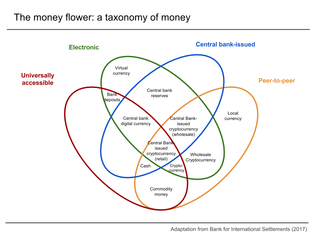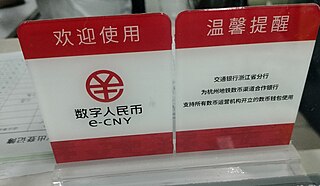
The Federal Reserve System is the central banking system of the United States. It was created on December 23, 1913, with the enactment of the Federal Reserve Act, after a series of financial panics led to the desire for central control of the monetary system in order to alleviate financial crises. Over the years, events such as the Great Depression in the 1930s and the Great Recession during the 2000s have led to the expansion of the roles and responsibilities of the Federal Reserve System.

Digital currency is any currency, money, or money-like asset that is primarily managed, stored or exchanged on digital computer systems, especially over the internet. Types of digital currencies include cryptocurrency, virtual currency and central bank digital currency. Digital currency may be recorded on a distributed database on the internet, a centralized electronic computer database owned by a company or bank, within digital files or even on a stored-value card.
ISO 20022 is an ISO standard for electronic data interchange between financial institutions. It describes a metadata repository containing descriptions of messages and business processes, and a maintenance process for the repository content. The standard covers financial information transferred between financial institutions that includes payment transactions, securities trading and settlement information, credit and debit card transactions and other financial information.

The Federal Reserve Bank of St. Louis is one of 12 regional Reserve Banks that, along with the Board of Governors in Washington, D.C., make up the United States' central bank. Missouri is the only state to have two main Federal Reserve Banks.

Fedwire is a real-time gross settlement funds transfer system operated by the United States Federal Reserve Banks that allows financial institutions to electronically transfer funds between its more than 9,289 participants. Transfers can only be initiated by the sending bank once they receive the proper wiring instructions for the receiving bank. These instructions include: the receiving bank's routing number, account number, recipient’s name and dollar amount being transferred. This information is submitted to the Federal Reserve via the Fedwire system. Once the instructions are received and processed, the Fed will debit the funds from the sending bank's reserve account and credit the receiving bank's account. Wire transfers sent via Fedwire are completed the same business day, with many being completed instantly.
Payment and settlement systems are used for financial transactions in India. Covered by the Payment and Settlement Systems Act of 2007, legislated in December 2007, they are regulated by the Reserve Bank of India (RBI) and the Board for Regulation and Supervision of Payment and Settlement Systems.
The National Payments Corporation of India (NPCI) is an organization that operates retail payments and settlement systems in India. The organization is an initiative of the Reserve Bank of India (RBI) and the Indian Banks' Association (IBA) under the provisions of the Payment and Settlement Systems Act, 2007, for creating a robust payment and settlement infrastructure in India.
The Clearing House is a banking association and payments company owned by the largest commercial banks in the United States. The Clearing House is the parent organization of The Clearing House Payments Company L.L.C., which owns and operates core payments system infrastructure in the United States, including ACH, wire payments, check image clearing, and real-time payments through the RTP network, a modern real-time payment system for the U.S.

Revolut is a global neobank and financial technology company based in London, England. It offers banking services for retail customers and businesses. It was founded in 2015 by Nikolay Storonsky and Vlad Yatsenko. It offers products including banking services, currency exchange, debit and credit cards, virtual cards, Apple Pay, interest-bearing "vaults", personal loans and BNPL, stock trading, crypto, commodities, human resources and other services.

Unified Payments Interface, commonly referred to as UPI, is an Indian instant payment system as well as protocol developed by the National Payments Corporation of India (NPCI) in 2016. The interface facilitates inter-bank peer-to-peer (P2P) and person-to-merchant (P2M) transactions. It is used on mobile devices to instantly transfer funds between two bank accounts. The mobile number of the device is required to be registered with the bank. The UPI ID of the recipient can be used to transfer money. It runs as an open source application programming interface (API) on top of the Immediate Payment Service (IMPS), and is regulated by the Reserve Bank of India (RBI). Indian Banks started making their UPI-enabled apps available on Google Play on 25 August 2016.

A central bank digital currency is a digital currency issued by a central bank, rather than by a commercial bank. It is also a liability of the central bank and denominated in the sovereign currency, as is the case with physical banknotes and coins.
Diem was a permissioned blockchain-based stablecoin payment system proposed by the American social media company Facebook. The plan also included a private currency implemented as a cryptocurrency.

The economic policy of the Joe Biden administration, dubbed Bidenomics, is characterized by relief measures and vaccination efforts to address the COVID-19 pandemic, investments in infrastructure, and strengthening the social safety net, funded by tax increases on higher-income individuals and corporations. Other goals include increasing the national minimum wage and expanding worker training, narrowing income inequality, expanding access to affordable healthcare, and forgiveness of student loan debt. The March 2021 enactment of the American Rescue Plan to provide relief from the economic impact of the COVID-19 pandemic was the first major element of the policy. Biden's Infrastructure Investment and Jobs Act was signed into law in November 2021 and contains about $550 billion in additional investment. His Inflation Reduction Act was enacted in August 2022.

Digital renminbi, or Digital Currency Electronic Payment, is a central bank digital currency issued by China's central bank, the People's Bank of China. It is the first digital currency to be issued by a major economy, undergoing public testing as of April 2021. The digital RMB is legal tender and has equivalent value with other forms of renminbi, also known as the Chinese yuan (CNY), such as bills and coins.
The recent history of central bank digital currencies (CBDCs) has been marked by continuous exploration and development. By March 2024, over 130 countries were actively engaged in CBDC research with 3 countries, territories or currency unions having launched CBDCs, and 36 implementing pilot programs.
The E-Cedi is a proposed central bank digital currency (CBDC) for Ghana. Dr. Ernest Addison is the Governor of the Bank of Ghana. In June 2021, he announced the development of the E-Cedi.

The Digital Rupee (e₹) or eINR or E-Rupee is a tokenised digital version of the Indian Rupee, issued by the Reserve Bank of India (RBI) as a central bank digital currency (CBDC). The Digital Rupee was proposed in January 2017 and launched on 1 December 2022. Digital Rupee is using blockchain distributed-ledger technology.
mBridge is a multi-CBDC platform developed to support real-time, peer-to-peer, cross-border payments and foreign exchange transactions using CBDCs. Based on a blockchain called the mBridge Ledger, the platform is designed to ensure compliance with jurisdiction-specific policy and legal requirements, regulations, and governance needs.
A Digital Euro, is the project of the European Central Bank (ECB), decided in July 2021, for the possible introduction of a central bank digital currency (CBDC). The aim is to develop a fast and secure electronic payment instrument that would complement the Euro for individuals and businesses in its existing form as cash and in bank accounts, and would be issued by the European System of Central Banks of the Eurozone.
Mojaloop is an open-source software project of the Mojaloop Foundation. The project is a reference model for creating interoperable payments platforms for digital financial providers intended to reduce the technical barrier of financial inclusion efforts. It was created and released by the Bill & Melinda Gates Foundation’s Level One Project in 2017. Moja is a Swahili word meaning "one".









